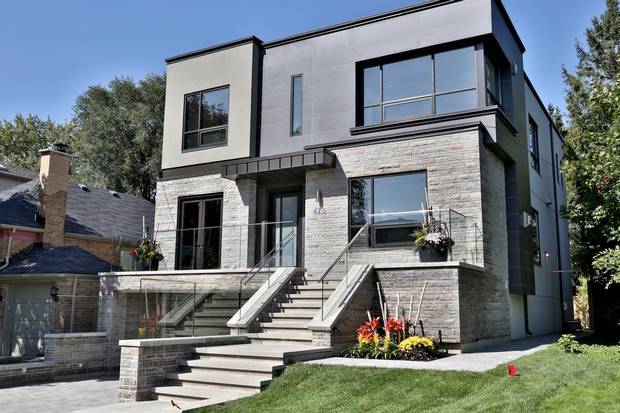An Architectural Facelift: The art of rejuvenating tired residences

2016
The art of transforming an unattractive house into something of beauty is much like Rumpelstiltskin spinning straw into gold thread. This is one of the architectural challenges that I truly relish. Dealing with the constraints of an existing house can be quite difficult; however, the rewards of a job well done are not only fulfilling as an architect, but also valued by the neighbourhood as a welcome addition to the existing streetscape.
There is also the benefit of preserving the present housing stock and not carting an existing home off to the landfill before its time. In this economy, many clients are looking to renovate instead of tearing down and building a new house. For this article, I have included examples of alterations to two houses that were both experiencing an identity crisis.
The first example is a Forest Hill house that had no personality. This home was a classically inspired Georgian house without a front entrance facing the street, resulting in a house without any prominence. Having once renovated the house years earlier for a previous owner, I knew exactly what the house was missing to bring it up to snuff with its elegant neighbours –– a formal sense of arrival. In this case, a new front entry hall was added to the south side of the house. (The existing entrance was on the north side through a car port.) The interior of the house was reorganized to have a more logical flow for the young family moving to Toronto. We were also able to enhance the entrance from the driveway with the introduction of a raised terrace, classical ionic order columns, and an entablature.
All the details were expertly cut out of limestone, including the terrace piers and balustrades. The attention to landscaping was also instrumental in defining the front yard and entrance with gates and walkways combined with formal plantings and urns. The entrance hall inside is now a wonderful introduction to this formal house, complete with marble floors, copper skylight, and a fireplace where one can sit and relax in a sun-drenched room that also acts as a private sitting area.
The second house is a North Toronto home that we added a rear addition to many years ago. When the client called me again to talk about a facelift for the front of the house, I was more than happy to help transform the “ugly duckling.” The house had no describable style, except for a close resemblance to the local McDonalds with the shingled Mansard roof covering the partial second floor. The couple had assumed that I would produce the typical stucco “faux Chateau” that is seen in so many neighbourhoods these days. These are inexpensive Band-Aid approaches to renovations that have very little to do with style. In other words, they are solutions to a design problem that prove to have little soul.
Knowing the personalities of the owners, one a stylish academic and the other a “renaissance guy” (who in his spare time plays piano, records music, does carpentry, and is a computer genius), I had an inkling that something more contemporary would suit their personalities. The first sketches came to me very quickly as I sat down to put pen to paper, though I was reluctant to show them, as I was unsure the owners would be open to something so different from what they were expecting. To my delight, they loved the drawings, and our journey began to truly transform this house into something of beauty.
The existing living room became a storey-and-a-half space for musical recording and performances, and a new master suite was created out of the old bedroom above the garage. In addition, a roomy front entrance, both inside and out, featuring floating Santos wood stairs, and 10-foot-high crotch mahogany closets, was created to make the experience of entering the house a pleasant one. In their former life, these components were poorly thought out resolutions.
The importance of these elements is now expressed on the front elevation with high windows for the music room, and through a series of fun, cascading windows for the master suite. A 10 foot high glass door with sidelites and a covered cantilevered copper canopy mark the front entrance, giving a grander sense of arrival.
The façade is a play of interlocking horizontal and vertical details that are further distinguished by the use of smooth and rough cut Eramosa stone –– some cut along the grain and others against the grain, further playing up the textural change. The Eramosa is continued on the front steps, patio and walkway to provide a homogenous look. The natural interior Santos wood and exterior teak wood windows, combined with copper flashings and a copper garage door, give a natural and clean look to the house that the clients are exceptionally proud of. Further enhancing the front of the house is an elegant, modern and natural approach to the landscaping featuring Eramosa retaining walls and native grasses.
It is one of my great joys as an architect to have the opportunity to take a home with little character and give it a personality and a soul. There are few things so rewarding to me as making “a silk purse out of a sow’s ear,” and there is comfort in knowing that a well-planned renovation can help reduce the ecological impact by sparing the existing housing stock from landfill. Fortunately, one does not need to engage the services of a Rumplestiltskin to create a miracle. Sometimes it just takes the imagination of a well-trained architect to show the client a world of possibilities.
Categorized in: Architecture News
